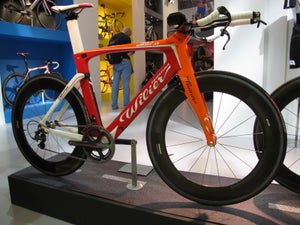Is Fatter Faster? Eurobike: 2012 Wilier TwinFoil

<h4>Click here to view a photo gallery of the bike.</h4>
Wilier is ditching the swooping gull-like tube shapes used on their current tri bikes and replacing them with more traditional aero profiles. Although the 2012 TwinFoil’s frame has a more traditional shape than its predecessor, its front end is anything but standard.

Instead of integrating the front brake and aerobar attachment system in order to narrow the front end, the TwinFoil integrates those components and has two struts—the twin foils—extending from the top of the fork on either side of the headtube that connect with the stem piece. While many other tri bikes are getting progressively narrower, this design substantially broadens the bike’s frontal surface area. Although it seems counter-intuitive, Wilier asserts the blades next to the headtube in fact reduce drag. They say it helps “direct airflow through and round body parts as well as components and wheels,” which reduces aerodynamic drag. Although it takes a leap of faith to accept that a fat headtube reduces drag, Zipp’s Firecrest rimshapes and Specialized’s wide nosecone on the Shiv have demonstrated that sometimes shape trumps surface area and broad components can be aerodynamic. Unlike those products, however, the wide struts create a cavity at the bike’s leading edge. The openings between the headtube and the struts are intended to accelerate the air past and around the frame and rider to minimize pressure drag. A few aero products have slits designed with the same aerodynamic concepts in mind, notably Ridley’s tri and aero road bikes, but this is a unique application because the bike itself is broadened so substantially to create the slits.
The aerobar bolts to a proprietary stem piece that lines up with the twin blades. This modular system gives Wilier the flexibility to create a variety of stems to accommodate different fit preferences. The displayed model has a round 31.8mm clamp that is compatible with most standard aerobars.
The front brake is a V-brake design with arms that tuck completely behind the fork blades. The housing routes next to the headtube. The rear is also a V-brake and is positioned under the chainstays behind the bottom bracket. Housing routes into the stem and through the frame.
The seatpost bolt is recessed into the drive side of the frame.
The TwinFoil has vertical dropouts—easier wheel removal than horizontal dropouts—that can be moved fore-aft 6mm to position the rear tire close to or far from the frame.
The frame will be available in four sizes, and geometry across the range has moderately aggressive fit coordinates and a slack 76-degree seat tube angle.
Follow Triathlete.com tech editor Aaron Hersh @triathletetech for updates throughout the Eurobike trade show.